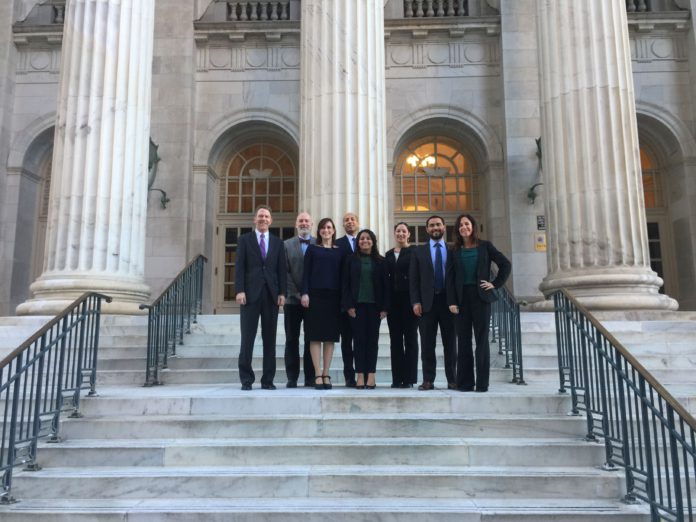

An event on the state of diversity in Colorado law, held Tuesday at the Byron White U.S. Courthouse, explored past, present and future issues of diversity and inclusion within the law profession. Denver Bar Association president Franz Hardy moderated a panel of minority bar presidents who shared their experiences and challenges practicing and engaging their memberships.
Hardy began by asking Colorado Bar Association president Richard Gast for his perspective on diversity in law and his observations about whether it has improved over the course of his career.
Gast pointed out that the state attorney registration form asks about gender but no other diversity criteria. The CBA membership form asks about race and ethnicity, but Gast said some don’t provide answers for that information.
“There’s probably a good opportunity here for some sort of comprehensive statewide survey,” Gast said. Skip Gray III, board member for the Center for Legal Inclusiveness, noted that CLI conducted an extensive survey in 2007 and encouraged teamwork between CLI and the bar associations to gather new data.
Asian Pacific American Bar Association president Justin Cohen said APABA has seen “tremendous” growth since its inception.
He mentioned that Colorado’s 1L Pledge to Diversity program is an initiative that he hasn’t seen in other states and is unique to the Front Range area.
Yamini Grema from the South Asian Bar Association noted that U.S. District Judge Christine Arguello’s Si Se Puede program, which addresses pipeline issues through mentorship for high school and college minority students, is another important initiative for increasing diversity.
Grema added that although she’s seen strides in diversity, that concept should be untangled from the notion of inclusion.
“I think one issue where we need to separate is diversity from inclusion. When we talk about diversity, we’re talking about straight representation,” Grema said. “Do we have a seat at the table? And in that sense, I feel like yes, these numbers are increasing. … But does that mean that inclusion has increased?”
Colorado Women’s Bar Association president Wendy Weigler said the association recently began to implement a strategic plan focused on diversity, because it had never tracked demographic information before. CWBA surveyed its members and received helpful feedback, but it wasn’t all positive.
“We received some negative comments that we were known as the ‘white women’s bar,’ and that was really hard to hear. I’m sure that is the perception, because we never tracked demographic information until very recently,” Weigler said.
Vanessa Devereaux, Sam Cary Bar Association president agreed with Grema on the issue of diversity versus inclusion. Devereaux said Sam Cary has heard from some of its members that they don’t see representation, inclusion or support in their firms.
Diving further into the issue, Hardy asked panelists to identify things they felt had not been accomplished.
“I’m hearing somewhat consistently that diversity as an overt metric has improved, but inclusion is something that we still need to work on,” Hardy said. “What have you inherited that you look back on and say, ‘boy, I wish we were further ahead, we’ve had decades now, and we’re not where were supposed to be?’”
LGBT Bar Association president John McHugh said the LGBT community is split into many different diversity intersections. McHugh said when he looks at representation on a national scale, sometimes there will be a “shocking” jump in the number of LGBT-identified attorneys.
“It’ll go from 1 percent of partners who identify as LGBT to something like 4 [percent]. The answer there is not there was a massive hiring of LGBT attorneys … but people felt comfortable in being out,” he said.
McHugh said he’s noticed it’s not uncommon to find “pockets” of LGBT attorneys at some firms in Colorado and then none at others, “because you find a safe space. It’s easier to be yourself at those [firms].”
Hardy acknowledged at the beginning of the panel that it was no coincidence the event was held the day after Martin Luther King Day. He quoted Dr. King’s dream of racial equality toward the end of the discussion, prompting panelists to respond to the question: Where do things stand today on the continuum of progress?
Panelists generally agreed that progress had been taken, but steps still need to be made.
Devereaux said she feels those steps start at the law school level through financial assistance and outreach programs for diverse students that then “flow into the practice,” and those efforts would help with retention of diverse students and attorneys in firms.
More than half of panelists expressed uncertainty about what is meant by “arriving” when Hardy asked “When will we get there?” But speakers still remained optimistic about efforts.
“The goal is for it not to just be a check in a box. … This goes beyond training and PowerPoints and having a diversity committee at your firm or organization,” Cohen said. “It’s really about changing attitudes such that we have a culture of openness and acceptance and respect and valuing differences, such that diversity and inclusion ironically become obsolete terms.”
— Kaley LaQuea

